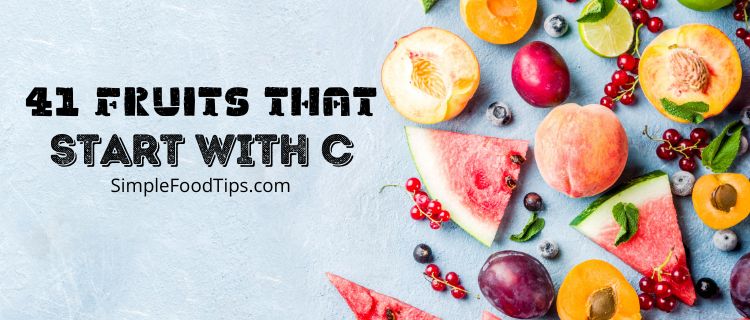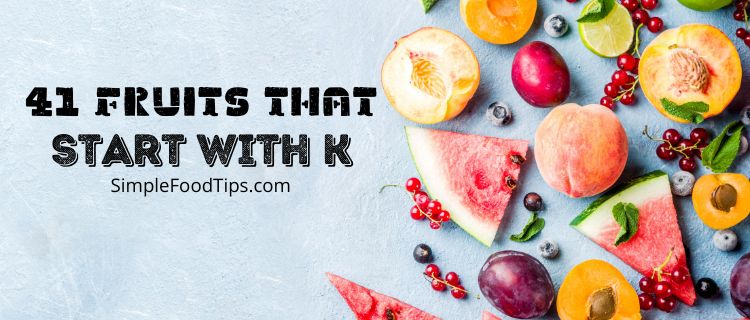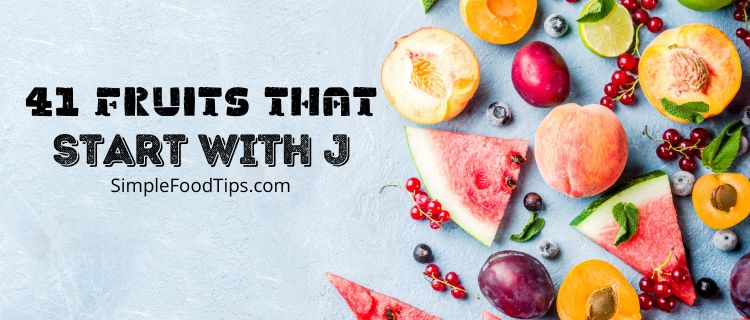There are many fruits that start with the letter C. This list will introduce 41 of them, including some lesser-known ones from around the world. Each fruit will have a description, including its benefits, where it is from, how it is consumed, and other important facts. So sit back and enjoy this delicious tour of 41 different fruits!
Outline
41 Fruits That Start With C
1. Cantaloupe
The cantaloupe is a type of muskmelon that originates from Persia. The word ‘cantaloupe’ actually comes from the Italian Cantalupo, which was the name of a papal estate where the melons were grown. The flesh is very sweet and has a slightly musky flavor. Cantaloupes are a great source of vitamins A and C, as well as potassium. They can be eaten fresh, or used in salads, juices, or smoothies.
2. Casaba Melon
Here is a winter melon that is native to Turkey. Casaba melon has a mild, sweet flavor and a creamy texture. The flesh is white or pale yellow and is often used in salads or as a garnish. Casaba melons are a good source of vitamins C and B6, as well as potassium and fiber.
3. Cherry
Cherries are small, red fruits that are related to plums and peaches. They are native to Europe and Asia but are now grown all over the world. Cherries have a sweet, tarty flavor and can be eaten fresh or used in pies, jams, or other desserts. They are an excellent source of vitamin C, and also contain vitamins A and E.
4. Coconut
Coconuts are not technically fruits, but drupes. It is the largest seed of a palm tree and is native to India and Sri Lanka. Coconut flesh has a sweet, creamy flavor and can be eaten fresh or used in many different recipes. Coconut milk is also popular and is made by blending the flesh with water. Coconuts are a good source of fiber, vitamins C and B6, as well as iron and magnesium.
5. Cranberry
Cranberries are small, red berries that are native to North America. They have a sour, tart flavor and are often used in pies or jams. Cranberries are also dried and used as toppings on salads and yogurt. They are an excellent source of vitamin C, and also contain fiber and manganese.
6. Cumquat
A cumquat is a small citrus fruit that is native to China. It resembles a small orange and has a tarty, acidic flavor. Cumquats are often used in marmalades or preserves. They are a good source of vitamins A and C, as well as potassium.
7. Currant
Currants are small berries that are related to gooseberries and grapes. They are native to Europe and Asia but are now grown all over the world. Currants have a sour flavor and can be eaten fresh or used in pies, jams, or other desserts. You will find vitamin C, along with other nutrients including fiber and manganese in these fruits.
8. Custard Apple
Native to South America, custard apples have green or yellow skins, and the flesh is white and creamy. The flavor is sweet and slightly acidic. Custard apples can be eaten fresh or used in desserts. They are a good source of vitamins C and B6, as well as potassium and fiber.
9. Caimito Fruit
Also known as star apple, caimito is a tropical fruit native to the Caribbean. It has green or purple skin, and the flesh is white with black seeds. The flavor is sweet and slightly acidic. Caimito fruits can be eaten fresh or used in juices or desserts. They are rich in vitamins C and B6, as well as potassium and fiber.
10. Calamansi
Calamansi is a small citrus fruit that is native to the Philippines. Being an excellent source of vitamin C, and also contain calcium and iron, it resembles a small lime and has a sour, acidic flavor. Calamansi is often used in marmalades or preserves.
11. Carambola
Also known as star fruit, carambola is a tropical fruit that is native to Southeast Asia. It has yellow or green skin, and the flesh is white with black seeds. The flavor is sweet and slightly acidic. Carambola fruits can be eaten fresh or used in juices or desserts. They are a good source of vitamins C and B6, as well as potassium and fiber.
12. Carob Fruit
The carob fruit is the seed of a Mediterranean tree. It is brown and has a sweet, chocolate-like flavor. Carob powder is often used as a substitute for cocoa powder. Carob fruits are a good source of fiber, vitamins C and B6, as well as iron and magnesium.
13. Cherimoya
Native to South America, the cherimoya are a good source of vitamins C and B6, as well as potassium and fiber. It has green or yellow skin, and the flesh is white and creamy. The flavor is sweet and slightly acidic.
14. Clementine
The clementine is a small citrus fruit that is a cross between a mandarin and an orange. It is native to China and Japan, but is now grown all over the world. Clementines have a sweet, tart flavor and can be eaten fresh or used in salads or desserts.
15. Coffee Fruit
The coffee fruit is the red or purple fruit that grows on the coffee tree. The fruit is often removed from the coffee beans before they are roasted. Coffee fruits have a sweet, tart flavor and can be eaten fresh or used in juices or smoothies. They are a good source of vitamins C and B6, as well as potassium and fiber.
You may also like:
16. Cucumber Fruit
Cucumbers are long, green vegetables that belong to the gourd family. They are native to India but are now grown all over the world. Cucumbers have a mild, refreshing flavor and can be eaten fresh or used in salads or as a garnish. They are a good source of vitamins C and K, as well as potassium and magnesium.
17. Currant Tomato
The currant tomato is a small, round tomato that is native to China. It is red or yellow in color, and has a sweet, tart flavor. Currant tomatoes can be eaten fresh or used in sauces or salads. They are very rich in vitamins C and K, as well as potassium and lycopene.
18. Cape Gooseberry
The cape gooseberry is a small, round fruit that is native to South America. These fruits taste sweet and tart. Cape gooseberries can be eaten fresh or used in pies, jams, or other desserts. They are an excellent source of vitamin C, and also contain fiber and manganese.
19. Crabapple
The crabapple is a small deciduous tree or large shrub, typically 4–12 m (13–39 ft) tall, with a dense crown. The fruit of the crabapple is small (1.5–2.5 cm or 0/6–1 in diameter), varies in color according to species from pale yellow to deep orange or red, and is either flushed with pink or marked with red streaks. The flavor can be tart but some varieties are sweet enough to be eaten raw.
20. Cempedak
Cempedak is similar in appearance to jackfruit, but it has a more distinct flavor. This fruit is often used in savory dishes, but it can also be eaten on its own. It’s high in vitamins and minerals, and it’s a good source of fiber.
21. Camu Camu Berry
This interesting fruit is native to the tropical regions of South America, and has a sweet and citrusy flavor. Rich in vitamins C, A, and B1, Camu Camu berries have potent antioxidant properties and can help boost the immune system. They’re also a great source of fiber.
22. Cherimoya
Native to South America, the cherimoya has green or yellow skin, and the flesh is white and creamy. The flavor is sweet and slightly acidic. They are a good source of vitamins C and B6, as well as potassium and fiber.
23. Calabash Fruit
The calabash fruit is a large, green fruit that is native to Africa. It has a hard shell and a soft, fleshy inside. The flavor is sweet and slightly acidic. Calabash fruits can be eaten fresh or used in juices or smoothies. They are an excellent source of vitamins C and B6, as well as potassium and fiber.
24. Chinese Quince
The Chinese quince is a small, round fruit with a yellow or greenish-yellow skin. Its flesh is white and crisp, with a slightly tart flavor. Chinese quinces are rich in vitamin C and antioxidants, making them a healthy addition to your diet. They can be eaten raw, cooked, or used in jams and jellies.
25. Chrysanthemum Fruit
Native to China, this small red fruit has a sour, tart flavor. Chrysanthemum fruits can be eaten fresh or used in juices or smoothies. They are an excellent source of vitamin C, and also contain calcium and iron.
26. Cloudberry
Cloudberries are small, red berries that grow in the wild in the northern hemisphere. They have a sweet, tart flavor. Cloudberries can be eaten fresh or used in pies, jams, or other desserts. They are an excellent source of vitamin C, and also contain fiber and manganese.
27. Chinese Chestnut
The Chinese chestnut is a large, round fruit with a thick, brown shell. Inside, you’ll find a white or yellowish flesh that’s sweet and nutty in flavor. Chinese chestnuts are a good source of fiber and vitamins C and B6. They can be eaten raw, roasted or candied.
28. Cookie Fruit
Native to the Caribbean, the cookie fruit is small and round with brown or black skin. The flesh is white and sweet. Cookie fruits can be eaten fresh or used in pies, jams, or other desserts. They are an excellent source of vitamin C, and also contain fiber and manganese.
29. Capuli Cherry
The capuli cherry is a small, red fruit that is native to South America. It has a sour, tart flavor. Capuli cherries can be eaten fresh or used in pies, jams, or other desserts. They are an excellent source of vitamin C, and also contain fiber and manganese.
30. Cupuacu
Cupuacu is a tropical fruit native to Brazil that has white flesh with a flavor similar to chocolate. It’s rich in antioxidants and vitamins C and B1, and has been traditionally used for medicinal purposes. Cupuacu can be eaten fresh or used in smoothies, juices, or desserts.
You may also like:
31. Cavendish Banana
The Cavendish banana is a long, yellow fruit that is native to Southeast Asia. It has a sweet flavor. Cavendish bananas can be eaten fresh or used in pies, jams, or other desserts. They are an excellent source of vitamin C, and also contain fiber and manganese.
32. Chico Fruit
The chico fruit is a small, round fruit that is native to South America. It has a sour, tart flavor. Chico fruits can be eaten fresh or used in juices or smoothies. They are an excellent source of vitamin C, and also contain calcium and iron.
33. Cartoon Fruit
With its bright orange color and distinctive cartoon-like shape, cartoon fruit is an interesting addition to any fruit salad. This citrusy fruit is packed with vitamin C and antioxidants, and has a tart flavor that’s great for adding zing to drinks or other recipes.
34. Cherry Of The Rio Grande
Native to South America, the cherry of the Rio Grande is small and round with a red or black skin. The flesh is white and sweet. Cherry of the Rio Grande fruits can be eaten fresh or used in pies, jams, or other desserts. They are an excellent source of vitamin C, and also contain fiber and manganese.
35. Citron
Citron is a large citrus fruit with a thick, bumpy skin and sour flesh. It’s rich in vitamin C and has been used traditionally for its medicinal properties. Citron can be eaten fresh or used in jams, jellies or other recipes.
36. Canary Melon
Native to China, this large fruit has a sweet flavor. Canary melons can be eaten fresh or used in juices or smoothies. They are an excellent source of vitamin C, and also contain potassium and fiber.
37. Canistel
Native to Central America, the canistel is a large, yellow fruit that resembles an egg. It has a sweet, custard-like flavor. Canistels can be eaten fresh or used in pies, jams, or other desserts. They are an excellent source of vitamin C, and also contain potassium and fiber.
38. Cabeluda
If you want to have a small green fruit that has a sour, acidic flavor, then this fruit from Brazil is right for you. Cabeludas can be eaten fresh or used in juices or smoothies. They are an excellent source of vitamin C, and also contain fiber and manganese.
39. Calamondin
Calamondin is a small citrus fruit that resembles a mandarin orange. It’s often used in Asian cooking, and has a sour flavor that’s great for adding zing to marinades or sauces. Calamondin is rich in vitamin C and antioxidants and has been traditionally used for medicinal purposes.
40. Chinese Jello Fruit
The Chinese jello fruit is a small, green fruit that is native to China. It has a sweet, slightly acidic flavor. Chinese jello fruits can be eaten fresh or used in juices or smoothies. They are an excellent source of vitamin C, and also contain calcium and iron.
41. Condalia
One of the lesser-known fruits on our list, condalia fruit is a small berry with an intensely sour flavor. Despite its tartness, it’s actually quite nutritious and contains high amounts of vitamins C and A. These nutrients can help boost the immune system, reduce inflammation and improve eye health.
So there you have it! 41 different fruits that start with the letter C. As you can see, there are a variety of fruits from all over the world that fall into this category. All of these fruits offer unique nutritional benefits, so be sure to add as many of them as possible to your diet. Which one is your favorite? Let us know in the comments below.
Related posts:



